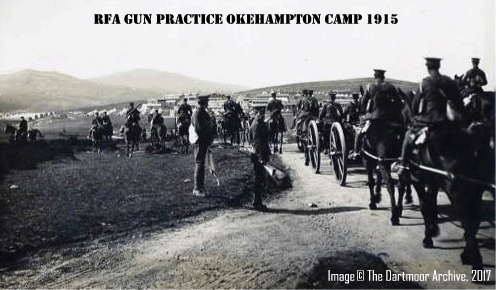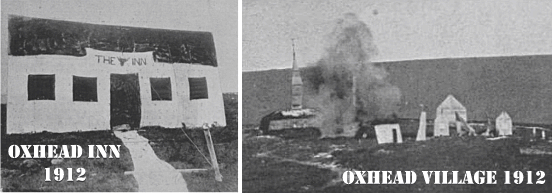
Look on any map of Dartmoor for the village of Oxhead, sometimes reported as Oxtend, and you will find no mention of it. However since the early 1900s it did exist on the northern part of Dartmoor and although many people actually saw it no trace of its inhabitants was ever found. This was not Dartmoor’s version of the mythical village of Brigadoon although over time it had ‘magically’ appeared only to vanish again on several occasions. So what was it?
As with any training exercise every effort is made to make them seem like a real battle scenario and at times great lengths to make them as realistic as possible. Today there are several purpose built dummy villages that the military use in their various training exercises such as that on Salisbury Plain. However this is not a modern invention and Dartmoor had it’s own mock village that was used in training exercises – it was called ‘Oxhead/Oxtend village. Here is an account of Oxtend Village written in 1907:
“I took a stroll through this ingenious model village this morning, shortly after the early sun had dispelled the steam-like mist hanging over the lofty landscape. A mounted artilleryman rode up to me and warned me that firing was shortly to take place. Beyond this, he did not check me. The situation chosen was the brow of Oxtend Hill, giving a spacious range, with a fine skyline. This frowning tor is some eight miles from Okehampton, the centre of veritable wilderness of gorse and heather, with the dark lagoon of Cranmere pool breaking the rugged monotony of the scene.
The village was built of wooden frames and canvas, every detail full sized, and almost startling in its realism. Smoke actually curling from one of the chimneys. A church and a spire overshadowed the main street. Arcadian looking cottages were relieved by the Oxtend Arms and a hospital flying the red cross flag, a windmill, the arms of which leisurely revolved in the warm wind, and a farmhouse. But most remarkable of all was the collection of dummy figures. Men, women, horses, and cattle were scattered about the silent grass-covered street, all mounted on wires so that the breeze kept them moving in a most life-like fashion. On the back of one of the dummy men some soldier-wag had affixed a placard bearing the inscription, ‘Don’t hit the inn, for heaven’s sake.’
The purpose of this elaborate piece of target work was to test the range and powers of the new 60-pounder guns. The heavy brigade of artillery, at present stationed at Okehampton carried out the bombardment. This brigade consists of two batteries of 60-pounders, each battery having four guns drawn by eight horses, and an experimental battery consisting of two 18-pounder guns, drawn by six horses apiece. The artillery came into action shortly after ten o’clock, the weather conditions being ideal for long range practice. Fire was opened at 8,000 yards, the range being gradually narrowed down to within 2,000 yards. For upwards of three hours was the gunnery maintained, with frequent lengthy intervals necessitated by the difficulty of shifting the big cannon, weighing five tons apiece over the broken ground of the moor. Shrapnel shell was principally used. A trench full of dummy soldiers rested across Hangingstone Neck with a mimic cannon which incessantly flashed forth in exact imitation of the real thing being electrically discharged. When this trench had been swept bare by the batteries a charge of cavalry took place. This was managed by setting free a number of dummy horsemen on a tramway line belonging to the War Office. They came skimming down the incline in fine style, but as they entered the fire-swept zone they toppled and vanished like rotten apples from a gale-shaken tree. No more realistic bit of mimic warfare has surely been enacted.
Oxtend village is a dismal spectacle in the deepening twilight of the lovely moor. The church spire is like a sieve, the clock alone being intact, with its hands set at twenty to one. Amongst the debris of the cottages lie many corpses; the picture is absolutely ghastly in its realism. I am told that the lessons taught by this most interesting experiment prove the terrible potency of our new guns in much higher degree than had been anticipated. A battery officer informed me that it had been abundantly manifested that nothing could live within 10,000 yards of a battery of 60-pounders.” – The Standard, September 20th, 1907.

In the June of 1912 the village once again magically reappeared out of the moorland mists only this time it was called Oxhead village. These exercises took place on Dartmoor part of which involved the 35th Field battery of the Royal Artillery. The first stage involved the big howitzer guns which were situated at Cullever Steps with their muzzles pointing across to Dinger Tor. The horses were drawn up for safety in a sheltered spot nearby. The targets that the big guns were firing at represented enemy infantry but initially their location was unknown to the gunners. The officers were stationed on Yes Tor who then relayed messages to the battery as to where they should drop their shells, this was done by either telephone, semaphone or morse code. The results of the shelling were then relayed back to the officers by the men in control of the targets. “The bang of the guns awoke echoes over the tors, and then puffs of blue smoke high above the moor indicated the direction of the shells.” During the exercise two other batteries, the 55th and 31st R.A. were engaged in a different scenario around Higher tor.
The next stage was to be an artillery bombardment on the village of Oxhead. It was estimated that the dummy village took two months to build, he ironic factor here is that although the construction of the village took weeks it would only take less than half a day to destroy, such again the efforts in striving for realism. From Higher Tor the ‘village’ took on the appearance of a huge white patch laying flat on the ground which covered between 15 and 20 acres in extent. Prior to the bombardment and as if by magic the village would literally rise out of the moorland landscape by means of wires attached to the canvas ‘buildings’. These included the resurrected cottages, the inn, the windmill, the church and on this occasion the addition ofa hospital. When the bombardment took place the aim of the gunners was to demolish all the buildings whilst leaving the hospital intact. Today with laser guided missiles this would be a relatively easy task but back in 1912 it demanded precision accuracy.

© London illustrated News of July 1912 – Mary Evans Picture Library
On the intended day of the attack there was some doubt as to whether it would take place due to the vagaries of the Dartmoor weather. The previous night a mighty gale howled across the moor, so strong were the winds that several of the marquees at the camp were flattened. Come day break heavy rain mixed with hail drenched the moor and it seemed as if there would be no firing that day. However eventually handkerchief-sized pockets of blue sky appeared over Yes Tor which was the signal to harness the horses and move out to Halstock. Meanwhile a party of men was dispatched to the village in order to erect the buildings. Unfortunately when they arrived it was discovered that some of the canvas fronts belonging to the mock cottages had been damaged. Instead of lying on the ground with the fronts facing skywards they had been inverted. Some of the other cottages had their fittings which fixed them to the ground broken. At the time the authorities were unsure as to whether the damage had been caused by ‘visitors’ to the village or if it the terrific storms were to blame. To make matters worse the strong winds had returned and when the men tried to hoist up the buildings they were nearly blown flat so it was decided to cancel the much awaited destruction of Oxhead village. Three days later the bombardment had still been postponed and it was reported that the village had been ‘blown to pieces by the strong wind’.
I have been unable to find any reports of the ‘now you see me, now you don’t’ village on Dartmoor after that of 1912. It could well be that the village lies dormant until magically reappearing during Britain’s next wartime hour of need along with its buildings and people?
 Legendary Dartmoor The many aspects past and present of Dartmoor
Legendary Dartmoor The many aspects past and present of Dartmoor
